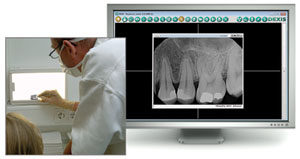By Lou Shuman DMD, CAGS
As the president of the Pride Institute, I have consistently encouraged the use of technology in the dental office.
Our research indicates that 81 percent of Americans between the ages of 30 and 49 are online daily. Patients have become educated consumers for their daily purchases as well as in choosing their practitioners; researching treatment options; obtaining patient feedback; and browsing practice Websites to increase their chances for a better dental experience. From the practitioner’s viewpoint, digital radiography is a superior technology over film that improves clinical assessment and greatly enhances treatment presentation.
When faced with implementing new technology, dentists often express budgetary concerns. In the current highly competitive and tight economic environment, although the initial outlay for an investment in digital radiography seems like the higher cost, practitioners should explore the true costs of staying with film—including what is spent on film, chemicals, and labor on an ongoing basis.
 Since research is the cornerstone of my business, and also my passion, I recommend that you do some research on your own business’ traditional film X-ray-related costs. Using your practice-management software, run a report on how many X-rays—including single PAs and bitewings, and all types of series—your practice generated in the last 3, 6, or 12 months to derive an average daily amount. Next, review your invoices for the same period to calculate the cost of film, mounts, processor chemicals (including cleaners), and your quarterly disposal fee. This will give you a better picture of what you are spending on these consumables.
Since research is the cornerstone of my business, and also my passion, I recommend that you do some research on your own business’ traditional film X-ray-related costs. Using your practice-management software, run a report on how many X-rays—including single PAs and bitewings, and all types of series—your practice generated in the last 3, 6, or 12 months to derive an average daily amount. Next, review your invoices for the same period to calculate the cost of film, mounts, processor chemicals (including cleaners), and your quarterly disposal fee. This will give you a better picture of what you are spending on these consumables.
To save time, DEXIS has an online calculator that allows you to plug in the average number of X-rays taken each day, which can be derived from your overall practice-management statistics. The tracker factors in the price for film, chemicals, and waste disposal and automatically calculates your monthly film cost. It then compares this total to a monthly rate for a digital radiography solution. Keep in mind that the calculation does not include labor, duplication costs, and postage for mailing film to insurance companies or referring dentists. I think you will be surprised to learn how much traditional film actually costs you to maintain, and in that light, how a digital X-ray system will comfortably fit into the budget—and be more economical over the course of your system ownership—especially if you already have computers in your operatory.
The return-on-investment in a digital system extends beyond the money saved on supplies. With digital radiography, besides the opportunity for better diagnosis, the dentist can explain that diagnosis more concisely. The result of increased patient communication is treatment acceptance. When patients are happy, they will tell their friends, most likely on Facebook, who may have otherwise just resorted to a Google search of dentists in the area, thus increasing your potential for referrals.
I urge you to take my digital challenge today at www.dexis.com/DigitalSavings. Compare the cost of film to the investment in digital-imaging technology. Once you look at the whole picture, the image of your future will be much clearer.
Dr. Shuman is not employed by Dexis. He does not act as a consultant for them nor does he have any financial interests in the company.
